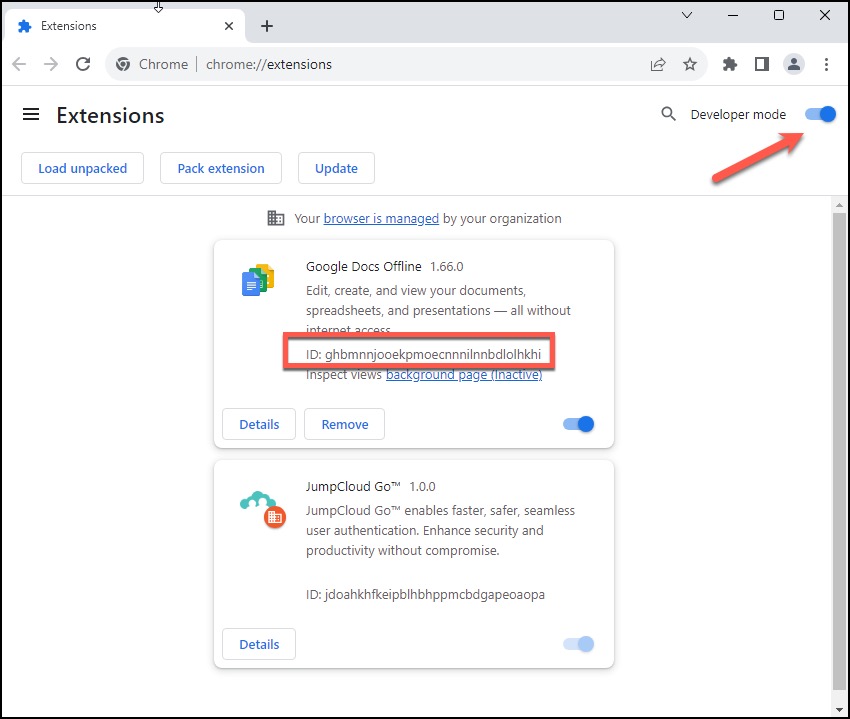Configure the Chrome Force-Installed Extension List policy to install and manage browser extensions for Google Chrome on macOS and Windows devices. Use this policy to force install JumpCloud Go, JumpCloud Password Manager, or any other extensions available in the Chrome Web Store. Force-installed extensions are automatically installed without user interaction, and users can't remove them.
This policy is for orgs that do not use Google Workspace and Chrome Enterprise (formerly Chrome Browser Cloud Management (CBCM). If your org uses Chrome Enterprise, instead manage extensions in the Google Admin Portal on the Apps & Extensions page using the Force-Installed Extension List. See Google's Chrome Enterprise Core and Create a Universal Browser Patch Policy to learn more. This policy isn't designed to be used with Chrome Enterprise, and doing so can cause conflicts in how Chrome policies are applied and prioritized. See Google's Understand Chrome policy management to learn more.
Use this policy to install the JumpCloud Go browser extension on managed devices, which is required for JumpCloud Go. JumpCloud Go enables secure passwordless user authentication to JumpCloud-managed web resources. See Get Started: JumpCloud Go to learn more.
Prerequisites:
- The target device is running macOS or Windows and the JumpCloud agent is installed. See JumpCloud Agent Compatibility, System Requirements, and Impacts.
- Google Chrome is installed on the target device.
Creating a Chrome Force-Installed Extension List Policy
To create a Chrome Force-Installed Extension List Policy:
If your data is stored outside of the US, check which login URL you should be using depending on your region, see JumpCloud Data Centers to learn more.
- Log in to the JumpCloud Admin Portal.
- Go to Device Management > Policy Management.
- In the All tab, click (+).
- On the New Policy panel, select the Mac or Windows tab.
- Select the Chrome Browser Force-Installed Extension Policy from the list, then click configure.
- (Optional) In the Policy Name field, enter a new name or keep the default. Policy names must be unique.
- (Optional) In the Policy Notes field, enter details like when you created the policy, where you tested it, and where you deployed it.
- Under Settings, complete these fields:
- Select JumpCloud Go to force install the browser extension on selected devices.
- Select JumpCloud Password Manager to install the browser extension on selected devices.
- (Optional) For Additional Chrome Browser Extensions, enter the Extension ID of any additional browser extensions you wish to force install. The extension ID is a 32-letter string found in the extension details in the Chrome Web Store, or in Chrome > Extensions > Manage Extensions with Developer mode enabled.
- (Optional) Under Update URL, define an update URL separated by a semicolon (;). This should point to an Update Manifest XML document. By default, the Chrome Web Store's update URL is used.
- Click the Devices tab to bind the policy to a device, or click the Device Groups tab to bind it to a group of devices.
- For device groups with multiple OS member types, the policy is applied only to devices running a supported OS.
- (Optional) Click the Policy Groups tab. Select one or more policy groups where you'd like this policy to be included.
For this policy to take effect, you must specify a device or a device group in Step 9.
- Click Save.
To verify the policy has applied on the device, go to Chrome and in the top right corner click the Extensions icon (puzzle). Verify that configured extensions are added.
Removing Devices from the Policy
If you used this policy to deploy browser extensions, you can remove associated devices or device groups in the Admin Portal to remove the extension from those devices.
To remove device or device groups from the policy:
- From the JumpCloud Admin Portal, go to Device Management > Policy Management.
- Select the Chrome Browser Force-Installed Extension Policy from the list, then click configure.
- For device group associations: Click the Device Groups tab, locate the group, and clear the checkbox to remove the association.
Removing a device group from the policy will remove installed extensions on all devices in that group.
- For direct device associations: Click the Devices tab and clear the checkboxes next to the associated devices.

